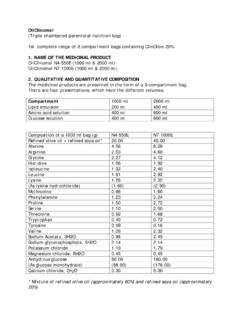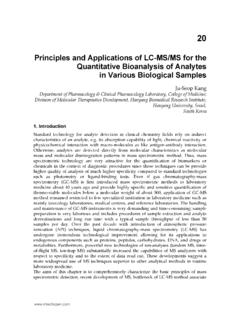Transcription of NEW ZEALAND DATA SHEET 1. PRODUCT NAME …
1 NEW ZEALAND DATA SHEET . 1. PRODUCT NAME. CILOXAN (ciprofloxacin hydrochloride) Eye Drops 2. qualitative AND quantitative COMPOSITION. Each mL of Ciloxan contains equivalent of 3 mg of ciprofloxacin base. Excipient with known effect Benzalkonium chloride mg in mL as a preservative. For the full list of excipients, see section 3. PHARMACEUTICAL FORM. Eye drops, solution. pH of approximately 4. CLINICAL PARTICULARS. Therapeutic indications Treatment of corneal ulcers, conjunctivitis and blepharitis caused by susceptible strains of bacteria in adults and children 12 months of age or older. Dose and method of administration Corneal Ulcers The recommended dosage regimen for the treatment of corneal ulcers is two drops into the affected eye every 15 minutes for the first six hours and then two drops into the affected eye every 30 minutes for the remainder of the first day.
2 On the second day, instil two drops in the affected eye hourly. On the third through to the fourteenth day, place two drops in the affected eye every four hours. Treatment may be continued after 14 days if corneal re-epithelialization has not occurred. Bacterial Conjunctivitis/Blepharitis The recommended dosage regimen for the treatment of bacterial conjunctivitis is one drop instilled into the conjunctival sac(s) every two hours while awake for two days and one drop every four hours while awake for the next five days. Contraindications A history of hypersensitivity to ciprofloxacin or any other component of the medication (See Section List of excipients).
3 A history of hypersensitivity to other quinolones, including nalidixic acid, may also contraindicate the use of ciprofloxacin. Special warnings and precautions for use FOR TOPICAL USE ONLY - NOT FOR INJECTION. FOR OCULAR USE ONLY. Serious and occasionally fatal hypersensitivity (anaphylactic) reactions, some following the first dose, have been reported in patients receiving systemic quinolone therapy. Some reactions were accompanied by cardiovascular collapse, loss of consciousness, tingling, Internal document code 1. cild13017iNZ. pharyngeal or facial oedema, dyspnoea, urticaria, and itching. Only a few patients had a history of hypersensitivity reactions.
4 Serious anaphylactic reactions require immediate emergency treatment with adrenaline and other resuscitation measures, including oxygen, intravenous fluids, intravenous antihistamines, corticosteroids, pressor amines and airway management, as clinically indicated. Moderate to severe phototoxicity manifested by an exaggerated sunburn reaction has been observed in some patients who were exposed to direct sunlight while receiving some members of the quinolone class of drugs, including oral ciprofloxacin. Excessive sunlight should be avoided. General As with other antibacterial preparations, prolonged use of ciprofloxacin may result in overgrowth of nonsusceptible organisms, including fungi.
5 If superinfection occurs, appropriate therapy should be initiated. When using Ciloxan eye drops one should take into account the risk of a rhinopharyngeal passage which can contribute to the occurrence and the diffusion of bacterial resistance. Whenever clinical judgment dictates, the patient's eye(s) should be examined with the aid of magnification, such as slit lamp biomicroscopy and, where appropriate, fluorescein staining. Ciprofloxacin should be discontinued at the first appearance of a skin rash or any other sign of hypersensitivity reaction. Tendon inflammation and rupture may occur with systemic fluoroquinolone therapy including ciprofloxacin, particularly in elderly patients and in those treated concurrently with corticosteroids.
6 Therefore treatment with Ciloxan Eye Drops should be discontinued at the first sign of tendon inflammation. Ciloxan eye drops contains benzalkonium chloride which may cause irritation and is known to discolour soft contact lenses. Contact lens wear is not recommended during treatment of an ocular infection. Therefore, patients should be advised not to wear contact lenses during treatment with Ciloxan eye drops. In clinical studies of patients with bacterial corneal ulcer a white crystalline precipitate located in the superficial portion of the corneal defect was observed in 35 ( ) of 210. patients. The onset of the precipitate was within 24 hours to 7 days after starting therapy.
7 In one patient, the precipitate was immediately irrigated out upon its appearance. In 17 patients, resolution of the precipitate was seen in 1 to 8 days (seven within the first 24-72 hours); in five patients, resolution was noted in 10-13 days. In nine patients, exact resolution days were unavailable, however, at follow-up examinations, 18-44 days after onset of the event, complete resolution of the precipitate was noted. In three patients, outcome information was unavailable. The precipitate did not preclude continued use of ciprofloxacin, nor did it adversely affect the clinical course of the ulcer or visual outcome (see : Undesirable effects). Paediatric use Safety and effectiveness in children below the age of 1 year particularly in neonates is very limited and have not been established.
8 Although ciprofloxacin and other quinolones cause arthropathy in immature animals after oral administration, topical ocular administration of ciprofloxacin to immature animals did not cause any arthropathy, and there is no evidence that the ophthalmic dosage form has any effect on the weight-bearing joints. Use of Ciloxan eye drops in neonates with ophthalmia neonatorum of gonococcal or chlamydial origin is not recommended as it has not been evaluated in such patients. Internal document code 2. cild13017iNZ. Neonates with ophthalmia neonatorum should receive appropriate treatment for their condition. Interactions with other medicinal products and other forms of interactions Specific drug interaction studies have not been conducted with ophthalmic ciprofloxacin.
9 However, the systemic administration of some quinolones has been shown to elevate plasma concentrations of theophylline, interfere with the metabolism of caffeine, enhance the effects of the oral anticoagulant warfarin and its derivatives and have been associated with transient elevations in serum creatinine in patients receiving cyclosporin concomitantly. Given the low systemic concentration of ciprofloxacin following topical ocular administration, drug interactions are unlikely to occur. Fertility, pregnancy and lactation Pregnancy Category B3. There are no adequate and well controlled studies in pregnant women. As a precautionary measure, it is preferable to avoid the use of Ciloxan during pregnancy.
10 Ciprofloxacin should be used during pregnancy only if the potential benefit justifies the potential risk to the fetus. See Section Preclinical safety studies for reproduction studies in animals. Breast-feeding It is not known whether topically applied ciprofloxacin is excreted in human milk, however, it is known that orally administered ciprofloxacin is excreted in the milk of lactating rats, and oral ciprofloxacin has been reported in human breast milk after a single 500 mg dose. Caution should be exercised when ciprofloxacin is administered to a nursing mother. Fertility Studies have not been performed in humans to evaluate the effect of topical administration of ciprofloxacin on fertility.
















